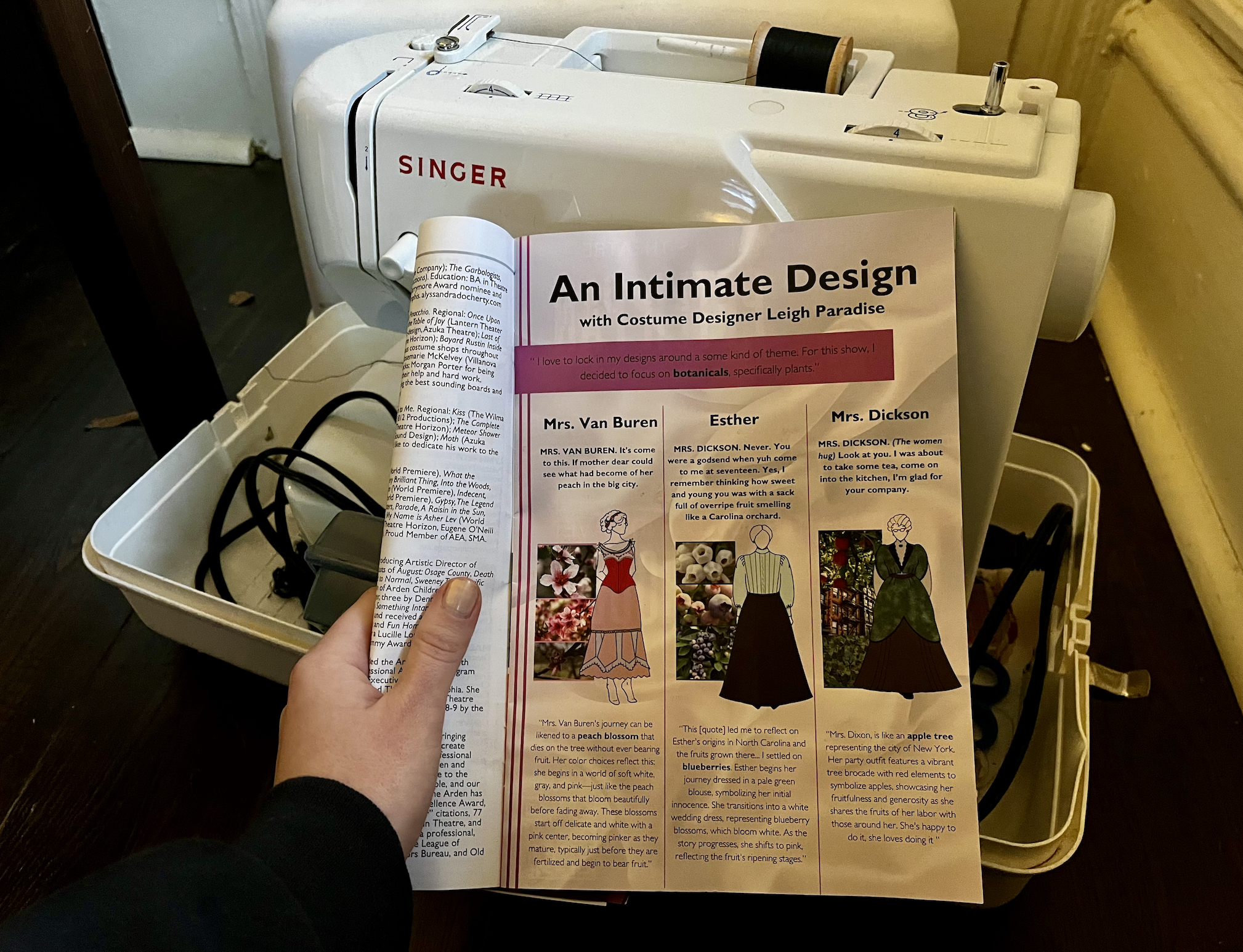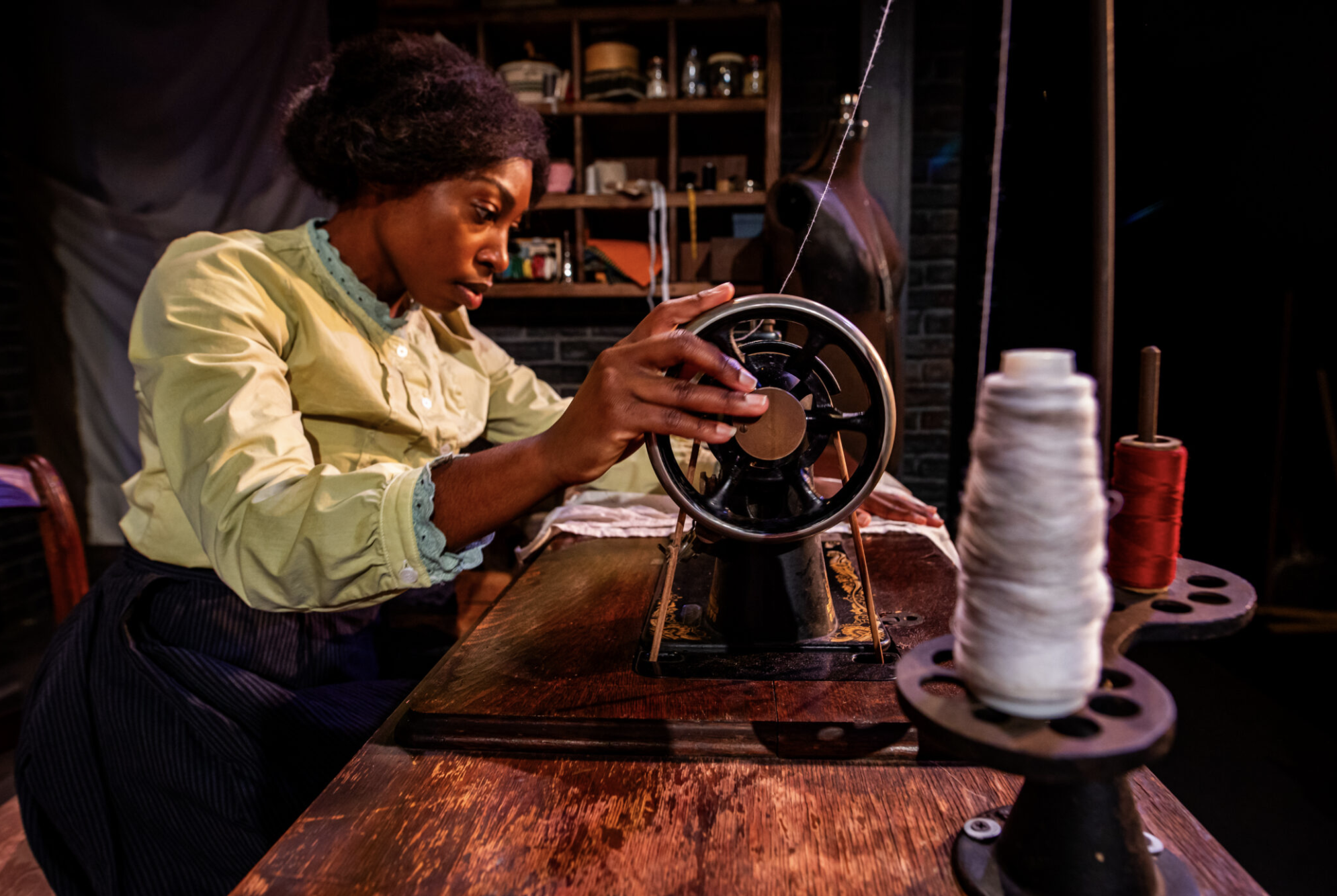Intimate Apparel
Arden Theatre
40 N 2nd St.
Philadelphia
Nov. 13, 2024
The theater is a uniquely intimate artistic arena; the only thing standing between actors and the audience is the veil of a stage. Lynn Nottage’s play Intimate Apparel plays with that sense of intimacy by spinning the story of the playwright’s grandmother, who worked as a lingerie seamstress in New York at the turn of the 20th century, into a patchwork of romantic illusions and harsh realities. Arden Theatre Company’s adaption follows the pattern of personality laid out in Nottage’s script, building breath into an extravagant bodice of history, character and entertainment.
I saw Arden’s performance Wednesday night. Here’s a free pattern I put together for anyone interested in learning how to sew together a seamless theatrical show.
- Pick the right fabric.
Arden started off on the right foot by picking the perfect play. Nottage unpacks from storage her familial history, exploring the historical context that shapes her characters’ desires, dreams and material worlds. The story follows Esther, a woman in search of beauty in a world built around power, not love.
“Intimate apparel” serves as a motif that allows us to understand the chain of labor that underlies the characters’ interests and motivations. Esther pours hours into crafting lingerie that clients describe as “feeling like Fifth Avenue,” underscoring the gap between the bare-bones reality of women striving for power in a racist, patriarchal world and the American dreams that they’re all searching to realize.
Although her profession offers rare financial independence, Esther wants to prove her own self-worth by fashioning herself into an object of male interest. She writes letters back and forth to a man stationed in Panama, working on digging the canal. “If importance be measured by how many men die, than this be real important work,” her suitor writes to her, describing the death toll of the operation. To him, Esther promises the potential of American mobility; to Esther, this man suggests a chance to experience true love rather than participate in the financial bargaining marriage represents.
In the end, the two marry and her husband turns out to be an abusive extractionist. Esther, whose dreams of opening a beauty parlor have been wrecked by his theft, must reconcile the difference between labors of love and playing pretend. Putting time into crafting something lovely, even looked-down-upon lingerie, is worth the effort — but lying to oneself in order to attract an alternative reality is a lost cause.
- Cut fabric on the dotted lines.
The theater crew took that lesson from Lynn Nottage and put their energy towards shaping two key components that bring the story alive: Costumes and casting.
Though Esther, who struggles with her apparent homeliness, is always dressed in drab attire, designer Leigh Paradise demonstrates the meaning of style by wrapping the play’s other characters in rich fabrics to paint fuller portraits of each person.
In the Playbill, Paradise explains how she chose to focus on botanicals to illustrate individual storylines: A white woman purchasing lingerie to maintain her husband’s devotion despite her infertility is dressed like a peach blossom. She wears soft white at the play’s beginning and hot pink towards the finale, indicating her own maturation over time. The owner of the rooming house where Esther lives is seen in patterns ripe with blueberries and apples, showcasing her generosity as she “shares the fruits of her labor with those around her.”
These details inform a fundamental argument written into the play: that love equals attention.
Similar attention was put towards casting. While lingerie gets at the tension between illusions of beauty and the truth of hard work, the actors’ appearances match the actuality of their character’s role. Though Esther complains of her ugliness, Brandi Porter, who plays Esther, is gorgeous. It’s a testament to the fact that beauty is in the eye of the beholder, and that even if Esther believes she’s hard to look at, her story and person are worthy of an audience.
- Select special stitching.
Though the show takes us around New York City — to places like a saloon owner’s bedroom and a Jewish immigrant’s fabric shop — those little worlds exists as props within the center stage of Esther’s sewing table. The set allows the characters to coexist around a central point of action. The intimate reckonings scripted through dialogue are made to feel familiar and active to a modern audience. The transitions that travel through place and time circle around Esther’s boudoir and secrets are revealed repeatedly within the confines of closet spaces: “Folks will pay a lot for your discretion,” Esther notes.
Nottage’s writing can at times feel oversaturated with meaning — she is trying to convey a lot over a short timespan. But the direction balances the highly metaphorical language with realistic stitching — there are plenty of quiet, erotic moments between characters and awkward silences that seamlessly mirror the pacing of real life. While the play is crafted as carefully as one of Esther’s garments, the directing monitors the illusion of art with a gentle realism that reminds us that truth is a work of art, too.
Intimate Apparel is playing through Dec. 1. Find show times and tickets here.







